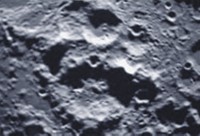Advertisement
Grab your lab coat. Let's get started
Welcome!
Welcome!
Create an account below to get 6 C&EN articles per month, receive newsletters and more - all free.
It seems this is your first time logging in online. Please enter the following information to continue.
As an ACS member you automatically get access to this site. All we need is few more details to create your reading experience.
Not you? Sign in with a different account.
Not you? Sign in with a different account.
ERROR 1
ERROR 1
ERROR 2
ERROR 2
ERROR 2
ERROR 2
ERROR 2
Password and Confirm password must match.
If you have an ACS member number, please enter it here so we can link this account to your membership. (optional)
ERROR 2
ACS values your privacy. By submitting your information, you are gaining access to C&EN and subscribing to our weekly newsletter. We use the information you provide to make your reading experience better, and we will never sell your data to third party members.
Physical Chemistry
LCROSS Hits The Moon
Planetary Science: Scientists will search for water in debris kicked up by spacecraft's impact
by Elizabeth K. Wilson
October 9, 2009

During a "flawless" performance on Oct. 9, the National Aeronautics and Space Administration's LCROSS spacecraft blasted a new small crater on the moon's surface near the moon's south pole, by first ejecting its spent booster rocket, and then by offing itself in a planned death plunge.
Analysis of the dust and debris kicked up by these impacts are expected to answer a key question about our moon's surface: Is there water in permanently shadowed craters near the moon's poles?
"We got the measurements we need to answer that question," a sleep-deprived but jubilant Anthony Colaprete, principal investigator for the mission, said at a press conference several hours after the impacts.
The impacts, which occurred in a south pole crater named Cabeus, did not appear to generate visible plumes of material, though spectrometers did register the impact by way of a strong sodium emission line. "We saw a crater, we saw a flash, so something had to happen in between," said NASA's Colaprete. The lack of a visible plume may say something about the composition of the surface.
After the booster rocket's impact, LCROSS scanned the ejected material, sent the data back to Earth, and then crashed itself into the moon's surface. Meanwhile, LCROSS's companion spacecraft, the Lunar Reconnaissance Orbiter (LRO), a long-term lunar orbiter that is now settling into orbit around the moon, recorded the events, collecting spectrometer data as well as visual and infrared images. LCROSS and LRO were launched together last June.
Additionally, a fleet of ground-based and space-based observatories, including the Hubble Space Telescope, the Keck Telescope on Mauna Kea, Hawaii, the Subaru Telescope in Hawaii, and the Palomar Observatory in southern California, also trained their instruments on the event.
The data from many of these telescopes has already been downloaded to Earth, and is currently being analyzed, Jennifer Heldmann, LCROSS Observation Campaign Coordinator, said at the conference.
Though mission scientists say they'll be able to get some answers from their data possibly even later in the day, they still plan to spend about two weeks rigorously and cautiously sifting through their data before announcing to the public whether the moon's craters contain water.





Join the conversation
Contact the reporter
Submit a Letter to the Editor for publication
Engage with us on Twitter